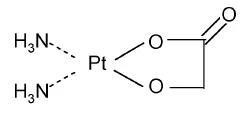Current location: Home > NEWS > Industry news
NEWS
PRODUCTS
Five platinum drugs inventory:except for nedaplatin,do you know more about others?
News source: Release time:[2021-10-28]
As an indispensable chemotherapeutic drug for moderncancer treatment, platinum drugs play an important role in tumor treatments.Platinum drugs is one of theanti-cancer drug family. It is known as an artifact for cancer chemotherapy, itseffect should not be underestimated.

As a broad-spectrum anticancer drug, platinum drugsare non-specific cell cycle chemotherapeutic drugs which are widely used inclinical practice. Its main mechanism of action is transporting transmembraneinto the cell, generating hydrated complex ions in the cell, forming aplatinum-DNA complex, cause DNA synthesis to be blocked, thus lead to celldeath.
Types of Platinum Drugs
There are currently three generations of platinumdrugs. The first generation is cisplatin,the second generation is carboplatin and nedaplatin while the third-generationdrug is lobaplatin and oxaliplatin. Due to the unique anti-cancer mechanism, platinum drugs are widely used in the treatment of commonmalignant tumors such as lung cancer, bladder cancer, ovarian cancer, cervicalcancer, esophageal cancer, gastric cancer, colorectal cancer, head and neck cancer.
Platinum drug on markettimetable
In 1978, the first-generation platinum drug cisplatinwas launched in the United States.
In 1986, the second-generation platinum drugcarboplatin was launched in the United States.
In 1995, the second-generation platinum drugnedaplatin was launched in Japan.
In 1996, the third-generation platinum drugoxaliplatin was launched in France.
In 2005, the third-generation platinum drug lobaplatin was launched in China.
What is the difference betweendifferent platinum drugs?
The difference between platinum drugs lies in theefficacy, side effects and the cross resistance.
Note: Cross resistance means that the tumor cells areresistant to some drugs while they are also resistant to the drugs with similarstructures or properties. They are divided into two types: complete crossresistance and partial cross resistance.
01 Cisplatin
Cisplatin, once known as "a model ofhigh-efficiency and high toxicity among chemotherapeutic drugs", rankedfirst among chemotherapeutic drugs. As a first-line drug, its effect is veryimpressive, and the anti-cancer regimens of cisplatin are also very diverse.

picture丨The chemical structure ofcisplatin.
Adverse Reactions
1. Nephrotoxicity: After using cisplatin, theperformance of nephrotoxicity is very obvious. Within 1 to 2 weeks ofmedication, renal tubular damage, hematuria, and elevated blood creatinine mayoccur. Currently, there is no other treatment method except hydration.
2. Gastrointestinal reaction: After using cisplatin,the patient's gastrointestinal reaction is also very obvious. The mainmanifestation is: acute vomiting may occur for 1 to 2 hours after taking thedrug and lasts for about 1 week. The countermeasure is to inject strongantiemetics.
3. Ototoxicity: Ototoxicity is strong, the degree isrelated to the amount of medication. The main manifestations are tinnitus,deafness, and irreversible high-frequency hearing loss. Cisplatin iscontraindicated in patients with otitis media. It is worth noting that thecombination of cisplatin and aminoglycoside antibiotics (streptomycin,gentamicin, etc.) can cause fatal renal failure and eventually deafness.
4. Myelosuppression is mild: if the dose is ≥120 mg/m2, the incidence ratecan reach 40%, which also overlaps with the bone marrow toxicity of otheranticancer drugs in combination chemotherapy. While White blood cells<3.5x109/L and platelets <75x109/L, it should be cautious.
As a second generation of anti-tumor drugs,carboplatin is also very popular. It is the second platinum complex to enterthe clinic. It is mainly used for small cell lung cancer, ovarian cancer,testicular tumors, head and neck squamous cell carcinoma, etc. Itscharacteristic is good chemical stability, lower gastrointestinal side effectsthan cisplatin. The tolerance of the patients for this drug is higher.

picture丨Thechemical structure of carboplatin.
Adverse Reactions
1. Thrombocytopenia is severe,the lowest point occurs in 2 to 3 weeks, and the recovery is in the 4th weekafter treatment.
2. Nausea and vomiting arecommon, usually appear 6 to 12 hours after treatment, and disappear within 24hours.
03 Nedaplatin
The second generation platinumdrugs produced in Japan are mainly used for esophageal cancer, non small celllung cancer, and small cell lung cancer. It is widely used in Asia, but rarelyused in Europe and America. Its broad-spectrum is not as good as cisplatin, andits efficacy varies from person to person.

picture丨Thechemical structure of nedaplatin.
Adverse Reactions
1. The gastrointestinal reactions of nedaplatin weremild nausea and vomiting, the incidence was 43.2% and 32.4%, respectively.
2. The myelosuppressive effect of nedaplatin is itsdose-limiting toxicity, which can lead to the reduction of white blood cells,red blood cells, especially platelets, and the incidence of bone marrowsuppression is 80%.
04 Oxaliplatin
Oxaliplatin is a third-generation platinum anti-tumordrug. It has no cross resistance with cisplatin. It is mainly used for advancedfirst and second line treatment of colorectal cancer and postoperative adjuvanttreatment. It is also used for ovarian cancer, breast cancer, gastric cancer,pancreas cancer, non-small cell lung cancer, melanoma, lymphoma, etc.

picture丨Thechemical structure of lobaplatin.
Adverse Reactions
1. Oxaliplatin, the third-generation platinum drug,has the least gastrointestinal reaction. When used alone, it is rare to causebone marrow suppression.
2. Its neurotoxicity is the most obvious, includingacute and cumulative neurotoxicity. It is mainly manifested as abnormal anddull hand, foot and perioral paresthesia, and reduced grip strength. Theduration is generally no more than 7 days. About 1% to 2% of patients haveacute laryngospasm. 85%-95% of patients will be stimulated and aggravated bycold.
05 Lobaplatin
Lobaplatin is a platinumdiaminomethyl-cyclobutane-lactate, developed by Germany. Its mechanism ofaction includes affecting DNA synthesis and replication, affecting theexpression of the original tumor gene c-mye. The expression of c-mye is relatedto tumor occurrence, apoptosis and cell proliferation.

picture丨 Thechemical structure of oxaliplatin.
Adverse Reactions
1. Lobaplatin has mild neurotoxicity. 1.3% of patientshave paresthesias, neurological diseases, neuralgia, and ototoxicity. Only 0.5%of patients have symptoms such as confusion and visual abnormalities.
2. The blood toxicity oflobaplatin is similar to oxaliplatin.
How to select platinum drugsfor cancer treatment?
Spacegen’s Human Pharmacogenomics SNP DetectionKit provide individualized and precise drug management for patients.Through genetic testing, it is possible to predict individual response tospecific drugs, help patients select appropriate chemotherapeutic drugs,improving the efficacy, and avoid serious side effects.
Detection Item
This kit detects 26 targetgenes and 33 sites at one time, guiding the evaluation of the efficacy and sideeffects of 19 first-line chemotherapy drug combinations
Detected Genes | The most Common chemotherapy drugs |
DPYD,UGT1A1,MTHFR,ERCC1,UMPS,CDA, DYNC2H1,DHFR,GGH,GSTP1,CYP2B6, SLC22A16,TP53,XRCC1,C8orf34,ABCC4, MTR,CBR3,CYP2D6,ABCB1,ABCC2,SOD2, XPC,SLC19A1,FOLR3,FCGR3A .Detect the above 26 target genes and 33 loci at one time. | cisplatin, carboplatin, oxaliplatin, |
PerformanceParameter
Product Name | Core Technology | Product Specification | Matched Instrument | Sample Types |
Human Pharmacogenomics SNP Detection Kit | RingCap® | 16 Tests/Kit or 32 Tests/Kit | Ion Torrent or Illumina | peripheral blood |
Advantage
Easy operation:;With independent patented RingCap® technology, libraryconstruction can be done in two steps.
Rapid Detection
Libraryconstruction takes only 3.5 hours. Only 2 working days from sample processingto reporting.
Accurate and Reliable
Usespecific primers to amplify and capture the target fragment, which is suitablefor peripheral blood samples.